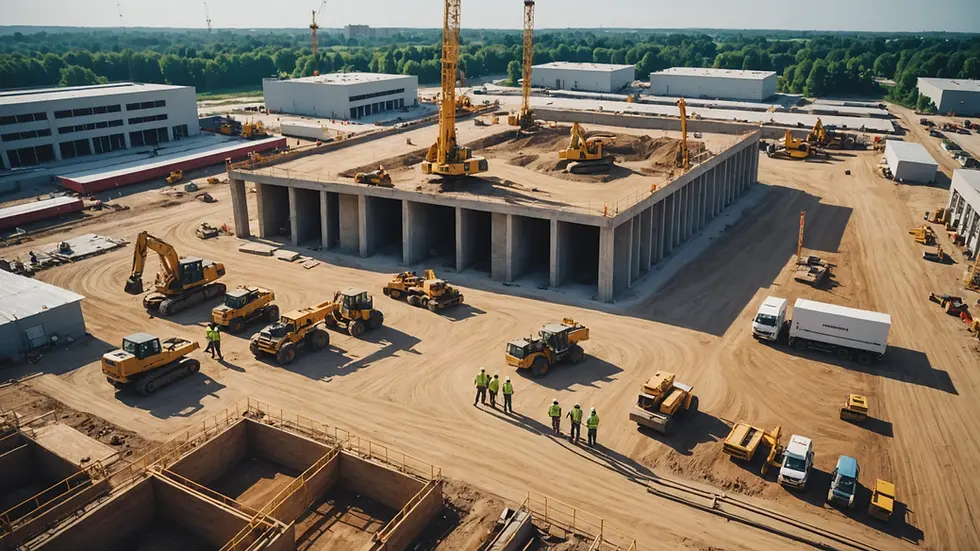The Game-Changing Impact of Building Information Modeling (BIM) on Construction Project Management: A New Era of Collaboration and Efficiency.
- Eng. Evans Nusu

- Feb 6
- 4 min read
Dramatic Changes in Construction Management
The construction industry faces constant challenges, from complex designs to tight deadlines. With demand for efficiency at an all-time high, construction professionals are turning to innovative solutions like Building Information Modeling (BIM). This digital approach revolutionizes the way teams visualize, manage, and execute projects, ultimately reshaping collaboration and communication.
As BIM continues to gain popularity across various sectors, it's clear that it not only improves how projects are executed but also fosters teamwork among different stakeholders. Let's explore how BIM is transforming the field of construction project management.
Enhancing Collaboration Among Teams
A Unified Platform
BIM serves as a centralized platform that brings together architects, engineers, contractors, and stakeholders. For instance, in a recent downtown skyscraper project, all parties accessed a single digital model that included design specifications, timelines, and budget constraints. This collaborative environment allows teams to work more effectively and prevents misunderstandings.
By breaking communication barriers, team members can visualize complex systems such as HVAC or electrical layouts, leading to smarter decisions. An impressive 80% of construction professionals reported improved teamwork and coordination after implementing BIM.
Improved Communication
Good communication is essential for project success. With BIM, teams use integrated software tools for messaging and document sharing, enabling real-time conversations and collaborative reviews. This immediate feedback minimizes costly delays and reduces potential misunderstandings.
For example, a construction project in Chicago experienced a 35% decrease in revision cycles due to the visual aids provided by BIM. By allowing non-technical stakeholders to see clear project visuals, everyone can discuss design options and budget limits effectively, creating a shared vision.

Stakeholder Engagement
BIM’s visualization tools significantly enhance stakeholder engagement. Investors and clients can readily grasp design concepts, even without technical backgrounds. Early involvement of clients in the design phase leads to better alignment with project objectives, which in turn results in smoother project delivery.
Additionally, having regular opportunities for stakeholders to review and provide feedback helps build trust and reduces costly late-stage changes. Statistics show that projects with stakeholder involvement in early design phases experience 25% fewer change orders.
Reducing Errors and Rework
Visualization and Prototyping
A standout benefit of BIM is its capability for 3D visualization. Teams can create detailed representations to spot potential conflicts early, such as issues with electrical systems clashing with plumbing designs. In a recent project, early detection of these conflicts saved the team over $120,000 in rework costs.
Streamlined Updates
BIM excels at providing real-time updates to project information. When unexpected issues arise, like a delay in material delivery, the model is quickly updated to reflect changes. A construction management firm in Seattle reported that this feature led to a 25% reduction in the use of outdated information, minimizing errors on-site.
Documented Comparisons
BIM also offers robust documentation features that track changes throughout the project's lifecycle. By maintaining clear records, teams can understand when and why modifications were made, reducing disputes and increasing accountability. In a six-month project assessment, teams that used BIM for documentation reported having 40% fewer disputes.

Enhancing Project Efficiency
Optimized Scheduling and Cost Management
BIM directly impacts project timelines and budgets. With the ability to simulate processes, teams can create accurate schedules, factoring in labor and material needs. This foresight allows potential delays to be addressed proactively, saving time and resources.
A construction team in Illinois was able to improve project completion rates by 30% by leveraging BIM for accurate scheduling and cost modeling. Accurate estimates from BIM can also reduce budget overruns, helping to avoid the common pitfalls facing many projects.
Efficient Resource Management
Effective resource management is essential for any construction project. BIM optimizes how materials and tools are allocated, ensuring they are available when needed. This increased efficiency leads to less waste—both in materials and time—resulting in more sustainable practices.
Continuous Improvement
BIM not only enhances current projects but also acts as a repository for valuable information for future ventures. For example, a firm that used BIM in one project found that lessons learned improved their next project by increasing on-time completions by 20%. This focus on continuous improvement fosters a culture of innovation among teams.
Overcoming Challenges and Considerations
Implementation Costs
Despite its many benefits, implementing BIM can require a significant investment. The costs of software, training, and potentially upgrading hardware need careful consideration. A recent survey found that companies that strategically planned their investments in BIM saw a return on investment of about 200% within two years.
Training Requirements
For BIM to be truly effective, team members must receive proper training. Investing in a structured training program is crucial to ensure that everyone understands how to make the most of BIM tools. Firms can expect that adequate training can enhance project efficiency by up to 25%.
Integration with Existing Workflows
BIM must fit well with existing project workflows. Organizations may struggle to align traditional methods with BIM. Gradually adapting workflows can help reduce resistance and promote a smoother transition. Companies that took this approach reported a 30% increase in user adoption rates for BIM technologies.
A New Direction for Construction Project Management
Building Information Modeling is fundamentally changing the landscape of construction project management. By fostering collaboration among teams, drastically reducing errors, and enhancing overall efficiency, BIM is setting new industry standards. However, its successful integration requires thorough planning, training, and a commitment to continuous growth.
As the construction sector embraces more technological solutions, digital transformation through BIM will shape its future. Organizations that harness this innovative tool will find themselves leading a more cooperative, efficient, and successful construction environment.
In summary, Building Information Modeling offers clear benefits for construction management. Organizations looking to enhance their processes should consider adopting BIM to streamline operations and improve overall project outcomes.












Comments